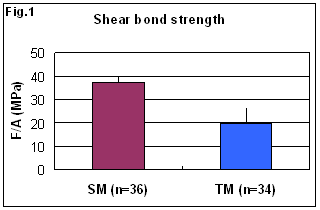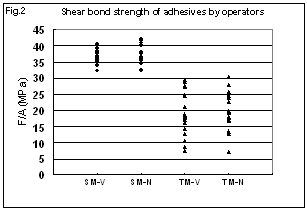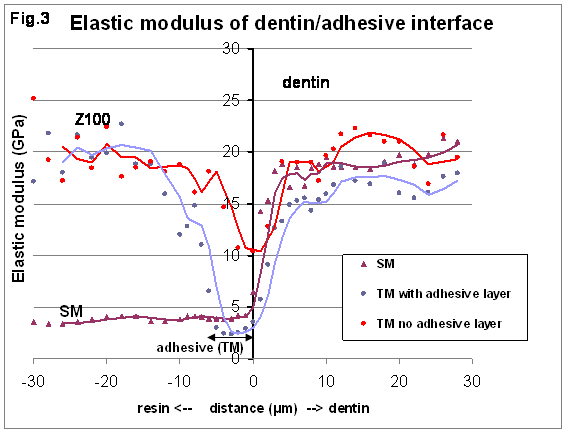Objectives: A new restorative material, BondFill(SM)(Sun Medical Co, Moriyama, Japan) was designed to withstand high shear stresses in areas such as occlusal facets and cervical defects. In this study we compared shear-bond strength and nanomechanical properties of its bonded interface with another self-etching system, EasyBond(TM)(3M).
Methods: Extracted human third molars were sectioned to yield proximal surfaces, finished to #320 roughness, and bonded by two operators veteran (V) and novice (N), using SM or TM, according to manufacturers' instructions. Specimens were stored 24h in 100% humidity before bond strength testing by the single plane shear test (n = 36/gp). Dentin occlusal bonded interfaces were cross sectioned and polished to 0.25μm with diamond paste for AFM-based nanomechanical determination of elastic modulus(E) and hardness(H) on wet specimens. Indentations were made at 1-2 Ám intervals across the bonded interfaces (n = 3/gp, 2 lines/specimen) with Triboscope system (Hysitron,MN). Statistics:1-way ANOVA.
Results: SM had higher shear-bond strength and smaller S.D.(p<0.001). There was no significant difference between operators for either system(p>0.05). TM tended to show non-uniform bonded interfaces with or without a detectable adhesive layer. E of specimens with visible adhesive layers did not recover to the E of sound dentin (17-20GPa) until ~10μm from interface. SM showed uniform interfaces and the affected dentin depth under the bonded interface was ~3μm. SM serves two roles, as adhesive and restorative material, and its E was lower than Z100.
Conclusions: SM had more uniform interfaces with smaller zones of demineralized dentin underneath, whereas TM showed variation in interface topography and mechanical properties. This may be the cause of TM's higher S.D. in bond strength tests. TM warrants further study to narrow the factors causing higher S.D. in bond-strength. SM requires clinical evaluation of the wear rate since it has lower mechanical properties than composite resin based restoratives.
Keywords: Adhesion, Composites, Dentin bonding agents, Hardness and Wear
![[ Visit AADR's Website ]](images/banner.jpg)


